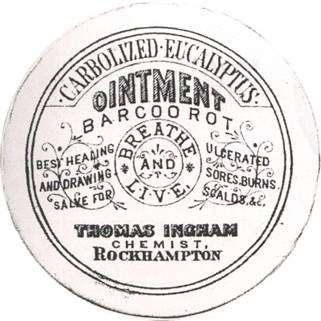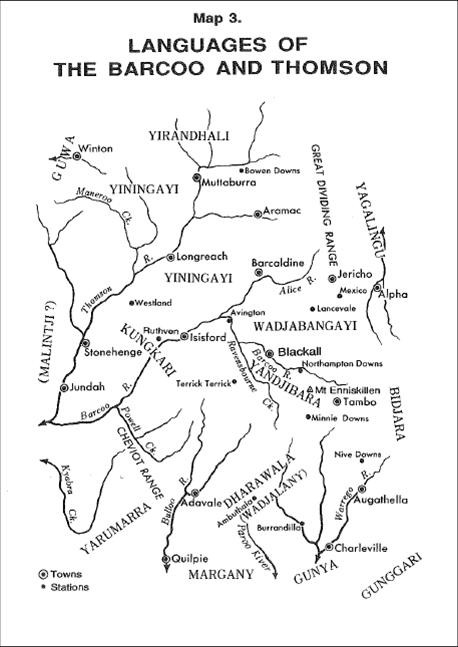On the outer Barcoo where the churches are few,
And men of religion are scanty,
On a road never cross’d ‘cept by folk that are lost,
One Michael Magee had a shanty.
From: ‘A bush christening’ by A B ‘Banjo’ Paterson (1893)
But what does the word actually mean and where did it come from?

Alice Downs Station on the Barcoo, 1878.
A preliminary search through the State Library Collections reveals that the word derives from Western Queensland and is attributed to the Birriya and/or Kungkari languages of the region centred on the Barcoo River. Localities in these language regions include Blackall, Jundah, Windorah and Isisford.
Did you know?
- It is possibly the only Australian river that finishes up as a creek! The Barcoo River, one of the great Western Queensland river systems, has its headwaters near Blackall, flows north-west before turning south to the Channel Country and becoming Cooper Creek.
- The Barcoo Shire is 61, 794 square kilometres (which equates to the area of Tasmania) and has a population of approximately 460 !
- The Macquarie Dictionary has three references featuring Barcoo: ‘Barcoo Rot’ a scurvy-like ailment from poor diet resulting in skin lesions; ‘Barcoo Salute’ meaning the ‘waving about of hands to keep flies away from your face’ and the ominous ‘Barcoo Spews’ which is vomiting caused by extreme heat.
- “Barcoo Rot” was sometimes described as ‘outback scurvy’ and the scourge of explorers, stockmen and drovers. The treatment for such a condition being “Barcoo Rot Ointment” – several Queensland chemists, including Thomas Ingham, a Rockhampton Chemist developed such ointments. In 1890, Ingham patented his carbolized eucalyptus ointment, advertising it as ‘a certain cure for Barcoo Rot’!
- Banjo Paterson and Henry Lawson were both inspired to write about the Barcoo in their writings; while Slim Dusty had several songs referencing the Barcoo.
- Barcoo was used as the name for two Australian Ships: SS Barcoo was a coastal steamer built in Glasgow in 1885 and plied the Queensland coastline, until 1911 when the ship was hulked and used as a Naval coal ship in Sydney Harbour before being scuttled in 1924. Photographs exist of the SS Barcoo at the ports of Mackay and Townsville. The second ship HMAS Barcoo was an Australian built anti-submarine frigate commissioned in 1944 and saw active service in the waters off New Guinea providing gun support and escort duties. Following a post-war refit, the HMAS Barcoo undertook survey and training duties until 1972 when it was decommissioned and sold for scrap to NW Kennedy Ltd of Vancouver, Canada.

Thomas Ingham "Barcoo Rot Ointment" potlid, c. 1890's.
Meanings for 'Barcoo'
A further analysis of items in State Library collections presented several alternative meanings and origins for further consideration.
Gavan Breen’s Salvage Studies of Western Queensland Aboriginal Languages (1990) presents the following information:
- ‘Barku’ is the Kungkari word for River and raises the possibility of anglicised spelling change to ‘Barcoo’;
- The Barcoo River refers to dividing country belonging to two tribes suggesting the Barcoo River serves as a boundary between two groups in the region ; and
- ‘Barracoo’ is given as the word for ‘big river / large creek’ in the neighbouring Guwa language.

Languages of the Barcoo and Thomson, Breen (1990)
Historically, the word ‘Barcoo’ has been in use since the mid-late 1800’s and recorded in Curr’s publication as well as the Queensland Place Names Board. The explorers Kennedy and Mitchell travelled through the area in 1846-1848 and there are references that both Mitchell and Kennedy initially referred to the river as the Victoria River. Mitchell hypothesised that it flowed to the Gulf; however Kennedy notes in his journal that a group of local Aboriginals provided him with the Aboriginal name of ‘Barcoo’ as being the name of the river.
In conclusion, there is always some uncertainty in translating Aboriginal words and their meanings – there are ‘shared ‘ words as well as words borrowed from other areas; e.g. ‘kangaroo’, ‘boomerang’, ‘yarraman’ and ‘didjeridu’. Additionally there is the potential for misinterpretation of words by others depending on the historical context and how the word/sounds have been heard and then written down. Bearing this in mind, it would be reasonable to assume that “barcoo” has a meaning of river in the Birriya and Kungkari languages of Western Queensland; the first reference to ‘Barcoo’ refers to the name of the River as recorded by Kennedy in 1847; I believe the popular meaning may have evolved from a weather event such as a hailstorm that occurred in a specific locality of the Barcoo River.
Note: Barcoo may be found in other Aboriginal languages and have a different meaning to those listed above; for example ‘Barkoo’ has been recorded as meaning a waddy/club and being from an unnamed Northern Australian language in one general collection of Aboriginal words; while ‘Barrku’ has been recorded as meaning 'far/far away' in the Datiway language of the Northern Territory.

Mail Coach at the Barcoo Hotel Blackall, 1897.
Desmond Crump, Indigenous Languages Coordinator
State Library of Queensland Aboriginal and Torres Strait Islander Languages Webpages
State Library of Queensland Aboriginal and Torres Strait Islander Languages Map
Jarjum stories: A kuril dhagun showcase focusing on children’s books and Aboriginal and Torres Strait Islander languages. 19 October 2019 to 10 May 2019.
Spoken: celebrating Queensland languages: A major exhibition exploring the survival and revival of Aboriginal and Torres Strait Islander languages throughout Queensland. Join in the many talks and events to celebrate the rich and diverse languages spoken today. 21 November 2019 to 19 April 2020.
References from the State Library Collections:
Breen, J.G. (1990) Salvage Studies of Western Queensland Aboriginal Languages. Pacific Linguistics Series B – No. 105. Australian National University: Canberra. J499.15 BRE
Curr, E. M. (1887) The Australian Race: its origins, languages, customs, place of landing in Australia and the routes by which it spread itself over that continent. John Ferres Government Printer: Melbourne. RBF 572.994 cur
Kennedy, E. B., Turner, A. A. and Blubber Head Press (1983) Kennedy, the Barcoo and beyond, 1847: the journals of Edmund Besley Court Kennedy and Alfred Allatson Turner with new information on Kennedy's life. Blubber Head Press: Hobart. J 919.4042 BEA
Mitchell, T. L. (1969) Journal of an expedition into the interior of tropical Australia: in search of a route from Sydney to the Gulf of Carpentaria. Greenwood Press: New York. J 919.404 MIT
Queensland Place Names Board (n.d.) Aboriginal place names, words and meanings collected at ‘Terrick Terrick’, Blackall, Central Queensland about 1886. Queensland Place Names Board: Brisbane. VF 919.43003 que
Queensland Place Names Board (1963) Interim Gazetteer of Queensland Place Names. Queensland Place Names Board: Brisbane. REF 919.43 1963
So keep giving a ‘Barcoo Salute’ to those flies; eat your veges and meat to keep the ‘Barcoo Rot’ at bay, stay out of the heat so you don’t catch a dose of the ‘Barcoo Spews’ and look out for those preachers on the outer Barcoo or you might end up christened after ‘Maginnis’s Whisky’!
Comments
Your email address will not be published.
We welcome relevant, respectful comments.